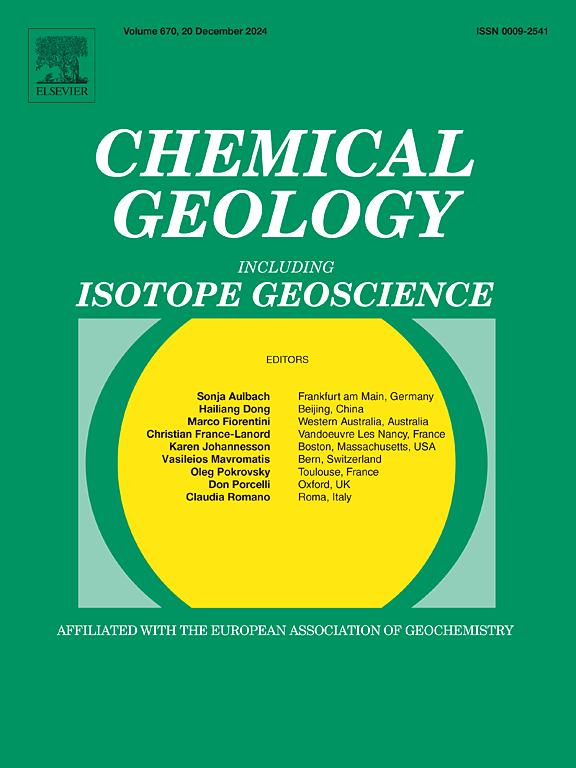Time constraints for the Lomagundi excursion and the earliest known Paleoproterozoic macroscopic organisms from the Francevillian Group, Gabon
IF 3.6
2区 地球科学
Q1 GEOCHEMISTRY & GEOPHYSICS
引用次数: 0
Abstract
The Francevillian Group, deposited during the Lomagundi carbon isotope excursion (LE), recently revealed evidence for complex and diverse Paleoproterozoic biota. This biota is preserved as pyritized and non-pyritized macrofossil structures hosted in black shale deposited in an oxygenated, open-marine environment. However, the timing of the LE, and the time when these macroscopic organisms evolved is still poorly constrained. Here, we present U-Pb ages for zircons separated from coeval volcaniclastic sandstone, 207Pb/206Pb model ages for pyrite preserving the macrofossils, and 40Ar/39Ar dates for K-rich clay minerals from the fossiliferous black shales. The youngest group of zircons yields a weighted average 207Pb/206Pb age of 2132 ± 4 Ma, which is considered as a maximum depositional age for the strata that record the LE and host the earliest known, macroscopic multicellular organisms. By contrast, the 207Pb/206Pb dates of pyritized fossils, scattering between ca. 2085 and 2070 Ma, with a weighted average of 2077 ± 17 Ma, reflect early diagenesis in the Francevillian basin and thus provide a minimum age for fossiliferous strata. This range of ages overlaps with reproducible 40Ar/39Ar dates and the ages for other open-marine sedimentary successions that record the LE in both shallow- and deep-marine environments. Taken together, the data demonstrate that the synchronicity of the record of the Lomagundi carbon isotope excursion in shallow- and deep-marine carbonates worldwide is consistent with a global biogeochemical signature of the Paleoproterozoic oceans, with its latest stage, between ca. 2.13 and 2.08 Ga, being preserved in the fossiliferous Francevillian Group strata. Further, the results also suggest that 40Ar/39Ar dating of K-rich clay minerals extracted from black shale can be used to constrain the depositional and/or early diagenetic age of more than 2-billion-years old sedimentary strata not affected by high-temperature hydrothermal and metamorphic overprint.
Lomagundi考察的时间限制和加蓬Francevillian群中已知最早的古元古代宏观生物
在Lomagundi碳同位素漂移(LE)期间沉积的Francevillian群最近揭示了复杂多样的古元古代生物群的证据。该生物群以黄铁矿化和非黄铁矿化的大化石结构保存在含氧、开放的海洋环境中沉积的黑色页岩中。然而,LE的时间,以及这些宏观生物进化的时间仍然没有得到很好的限制。在此,我们给出了从同世火山碎屑砂岩中分离出来的锆石的U-Pb年龄,保存宏观化石的黄铁矿的207Pb/206Pb模型年龄,以及来自化石黑色页岩的富k粘土矿物的40Ar/39Ar年龄。最年轻锆石组的207Pb/206Pb加权平均年龄为2132±4 Ma,这被认为是记录LE和已知最早的宏观多细胞生物的地层的最大沉积年龄。而黄铁矿化化石的207Pb/206Pb年龄分布在约2085 ~ 2070 Ma之间,加权平均值为2077±17 Ma,反映了Francevillian盆地的早期成岩作用,为化石地层提供了最小年龄。这一年龄范围与可重复的40Ar/39Ar年龄以及记录浅海和深海环境LE的其他开阔海相沉积序列的年龄重叠。综上所示,Lomagundi碳同位素漂移记录在全球浅海和深海碳酸盐岩中的同向性与古元古代海洋的全球生物地球化学特征一致,其最晚阶段约2.13 - 2.08 Ga,保存在化石Francevillian群地层中。此外,从黑色页岩中提取的富k粘土矿物的40Ar/39Ar定年可以用来约束超过20亿年未受高温热液和变质叠印影响的沉积地层的沉积和/或早期成岩年龄。
本文章由计算机程序翻译,如有差异,请以英文原文为准。
求助全文
约1分钟内获得全文
求助全文
来源期刊

Chemical Geology
地学-地球化学与地球物理
CiteScore
7.20
自引率
10.30%
发文量
374
审稿时长
3.6 months
期刊介绍:
Chemical Geology is an international journal that publishes original research papers on isotopic and elemental geochemistry, geochronology and cosmochemistry.
The Journal focuses on chemical processes in igneous, metamorphic, and sedimentary petrology, low- and high-temperature aqueous solutions, biogeochemistry, the environment and cosmochemistry.
Papers that are field, experimentally, or computationally based are appropriate if they are of broad international interest. The Journal generally does not publish papers that are primarily of regional or local interest, or which are primarily focused on remediation and applied geochemistry.
The Journal also welcomes innovative papers dealing with significant analytical advances that are of wide interest in the community and extend significantly beyond the scope of what would be included in the methods section of a standard research paper.
 求助内容:
求助内容: 应助结果提醒方式:
应助结果提醒方式:


